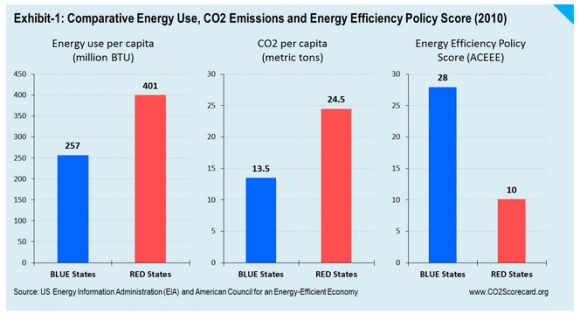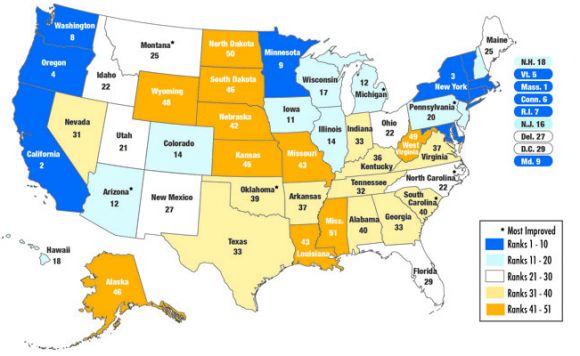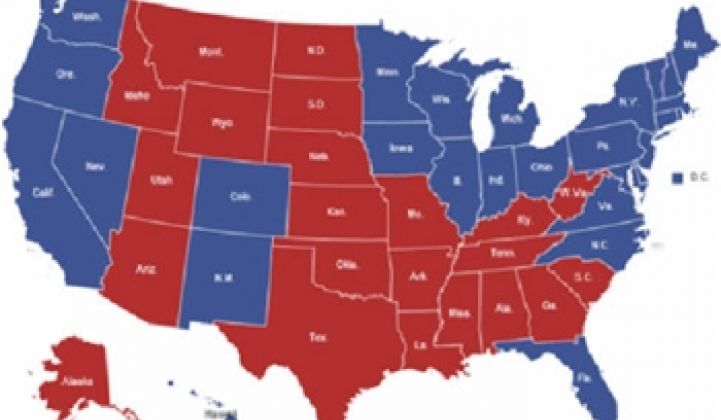Americans say they love efficiency and clean energy. Take a look at any poll asking people whether they support these sectors and you'll find strong agreement across party lines -- in theory, anyway.
Implementation is usually where things get partisan.
The promotion of efficiency, renewables, and other climate-friendly technologies is carried out through public policy in order to allow them to compete in a market dominated by legacy players. In reality, people on the political left are much more agreeable to government policies that explicitly benefit clean energy. And people on the right are much more skeptical of subsidies intended to promote a certain sector. A recent piece from the conservative Heritage Foundation on energy efficiency mandates illustrates this: of course, the author supports energy efficiency in theory; he just doesn't approve of explicit targets.
So how does this play out in the states where most of the energy efficiency policy efforts are underway? A new analysis from CO2 Scorecard shows a partisan divide there too, with so-called red states ranking far below blue states in terms of energy efficiency policies. As a consequence, Republican-leaning states use 55 percent more energy per capita than Democratic ones and emit nearly twice as much carbon.

There are a lot of variables that contribute to energy consumption in different states: electricity prices, the differences in rural and urban populations, and types of industry. The report authors, Shakeb Afsah and Kendyl Salcito, ran a regression model to account for these independent factors and found that they did indeed change the equation. However, even after accounting for the differences, energy consumption in red states was still 60 million BTUs higher per capita.
"The regression result confirmed the relevance of known variables. In addition, though, it demonstrated an astounding correlation between Republican [political affiliation] and high per-capita energy use, and this finding was consistent for each year between 2008-10," write the authors.
The key differentiator is policy. Take a look at the two maps below. The first one from ACEEE ranks states on their promotion policies for energy efficiency. The second one shows the breakdown of the 2012 electoral college. With a few outliers, the maps show that the top-ranking states are mostly blue and the lower-ranking states are mostly red.


So what are the implications of this policy divide? Afsah and Salcito broaden their conclusion well beyond efficiency, saying they believe "the rejection of energy efficiency by red states shows that climate pragmatism is a political fantasy."
"The striking difference in the adoption of energy efficiency policies in Democratic and Republican leaning states in the U.S. highlights the grim reality of political opposition to any comprehensive national-level climate action plan. Given the deep roots of Republican opposition to energy efficient policy shifts, a policy mix that includes carbon-tax and cap-and-trade faces even bleaker prospects," they write.
If we are to draw a conclusion based upon adoption of efficiency policies, there are other factors that counter this point. For example, the Lawrence Berkeley National Laboratory projects that lagging states in the South and Midwest will make up 50 percent of spending on utility programs by 2025, catching up to the West and Northeast. On the renewables side, renewable portfolio standards are solidly in place in both red states and blue states. In fact, 81 percent of wind projects are located in Republican districts. And let's not forget that President Obama won the coal states of Ohio, Pennsylvania and Virginia last year -- with a majority of voters in those states saying clean energy policies impacted how they cast their ballots.
At the same time, however, there are 42 legislative efforts to dismantle state-level renewable energy targets currently being pushed by Republicans across twelve states.
The politics and policies on the state level are mixed. What these experiences say about the ability to pass national climate legislation is less clear than this study concludes. But there are certainly differences in what Americans say they want for policy in theory and what actually happens politically in practice.



